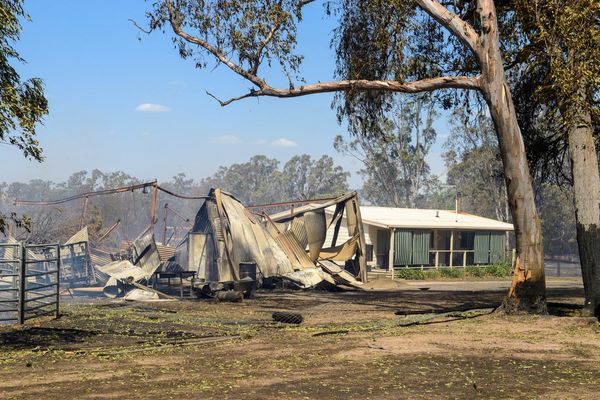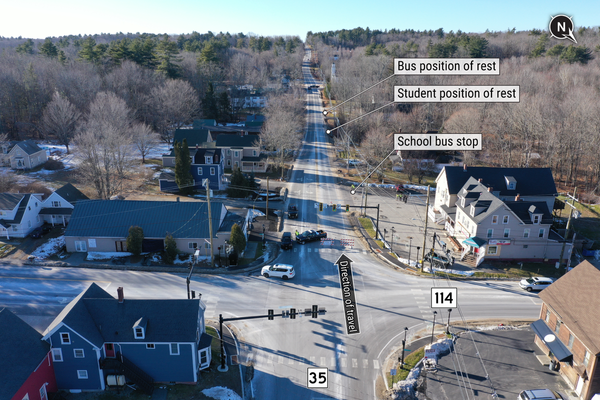Five days after much of his farm was submerged by floodwaters, Latrobe farmer Jason Deering has begun assessing the damage.
"It's probably around two kilometres of fencing that need to be redone there, and that's running about $10,000 a kilometre, so there's $20,000," he said.
"The last quote we got for the driveway, that's another $10,000, so that's $30,000... plus hay and silage that we're not going to be able to cut off that."
While he estimates the floodwaters were around half-a-metre lower than in 2016, the clean-up is still expected to take weeks.
It's a process that the Deerings haven't been able to start due to the severe damage to Railton Road.
"It's been six days without road access to be able to get into town, so it's hard to get fuel and things to do the clean-up," he said.
On Tuesday, he was finally able to make it into Latrobe to check in on the progress of the road repairs, but there was no-one to talk to.
"We were a bit disappointed State Growth weren't here. They were meant to be here today," Mr Deering said.
"That's who we mainly came to see, because Railton Road is a State Growth road and we wanted to talk to them about using some of their waste product to rebuild our road."
Residents of Latrobe, Launceston, Devonport, Kentish, Meander and Central Coast councils all qualify for the federal government disaster relief payments.
While those grants will help to cover the cost of essentials for people like the Deerings, the one-off lump sum won't come close to covering the cost of rebuilding.
Insurance system at 'peak capacity'
The Insurance Council of Australia says around 400 Tasmanians have already lodged claims with their insurance companies, but that number is expected to rise as more people return to their homes.
When those claims do start to roll in, they'll join an enormous queue of Australians who have been impacted by successive flood crises.
Insurance Council of Australia CEO Andrew Hall said insurers had paid out more than $5.3 billion so far this year, and more than 230,000 claims had been lodged since February.
"The insurance system is dealing with an absolute avalanche at the moment of flood claims across the east coast of Australia," he said.
The enormous volume of claims is slowing the process, as is the lack of tradespeople available to assess the damage bill.
"Simple claims can be processed quickly, but inundation can take a long time," Mr Hall said.
"The system is at peak capacity, we ask people to be patient, we'll work through these claims as quickly as possible."
With the Bureau of Meteorology predicting another 20-40 millimetres of rain could fall over parts of northern Tasmania this weekend, the Insurance Council is "very concerned" the list of flood claimants will grow longer.
If that occurs, Mr Hall expects this rainfall event will be declared a "catastrophe", and therefore affected people will be prioritised.
He predicts the repeated flood events will continue to drive insurance premiums up, and called on governments at all levels to do something about reducing flood risk.
"We need to be investing at least a billion dollars a year more in flood levees, in raising homes, and ultimately, going back and fixing past mistakes," he said.
"There are areas of this country where houses were built that should never have been built, and we need to make sure moving forward that development isn't approved in areas that are prone to flood."
Power station to remain offline
Aurora Energy has announced it will offer bill relief to flood-affected customers in the north and north-west.
The retailer says those experiencing financial difficulty can also apply to have feed and charges waived, and debts frozen.
Meanwhile, Hydro Tasmania has announced Poatina Power Station in the northern midlands will remain offline, after floodwaters caused machinery at the plant to fail over the weekend.
The state-owned power company says it has decided to shut off the hydro-electric station so that it won't contribute to the already flooded catchment below.
Hydro Tasmania's head of Assets and Infrastructure Jesse Clark told the ABC the rain would eventually assist the state's power generating capacity.
"The storage is sitting around 42 per cent, but as you can imagine a lot of the dams in the north are actually overflowing at the moment," he said.







